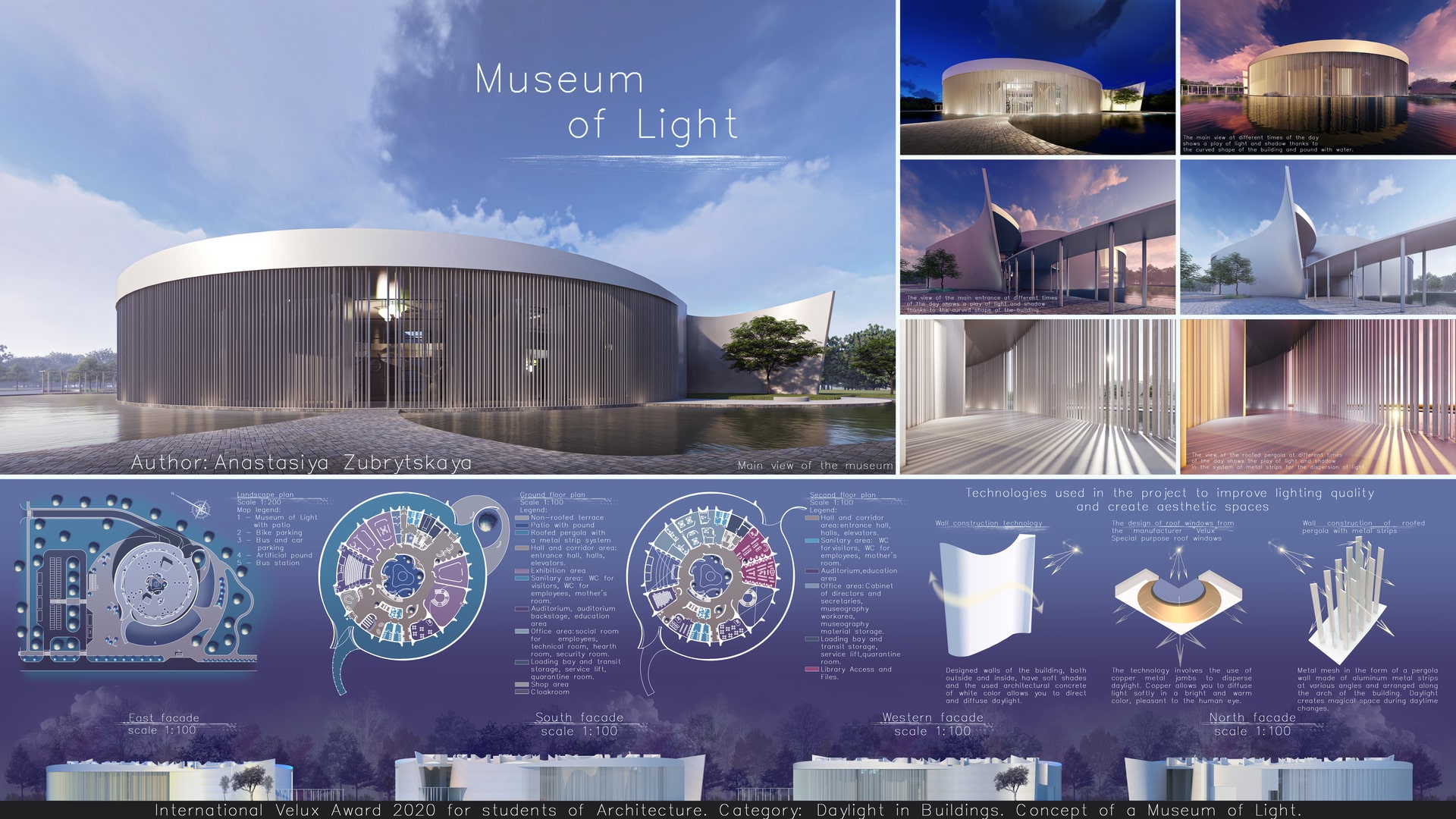Project Description
Hello, ladies and gentlemen! My name is Anastasiya Zubrytskaya. I’m a student of Lublin University of T in Poland. I am a second degree student at a my university, but I‘ve started my architecture education in Belarus. I have been studying architecture for a long time and I am delighted with the capability of man to create and implement magical projects. This is why I would like to present my project in the competition in the "Daylight in buildings" category. My project is presented in the form of the Museum of Light. Why did I chose this topic? While writing my thesis, I noticed the lack and insufficiency of information in Polish and Belarusian sources about the impact of light on humans, its importance for creating architecture, its ability to interact with other building materials. Then I had an idea to show the importance and beauty of light in architecture. Using what? What can involve education and also show the possibilities of light? The answer for this question was the Museum of Light. It may seems like an ordinary building, but with proper efforts and freedom of creation, I came up with an incredible concept. But what is so important and interesting about this project to qualify him for the chosen category of competition? What is so special about it? You have to look closely at the details, just like they are saying "the devil is in the details". 1. The first point is the sense and ideas that museum has. This kind of exhibition will be interesting for both child and adult visitor. An additional goal is to provide the ability to study light effects on people and living conditions. 2. The second point is to create the shape of entire building. Curved lines, slope at different angles and height changes create a play of solid shape of the building and allows to manage the daylight, coming into the building. When the room requires less light, the walls tilt and close, hiding internal space from the sun , when the room needs more light, the walls open to the sun. Nothing is accidental. The line that connects the entrance door shows the main axis of the sun movement around the building - East and West. The walls at the certain moment embrace a tree to expose it to the sun and hide a water pond to keep water in the “heart” of the building. Each wall contains the sense and ideas of nature and shows the importance of daylight not only for a man, but also for nature too. 3. The third point is the choice of material solutions. There are several important aspects to be noted. The building itself is bright and diffusing light through the use of architectural concrete of white color. Light and shadow, shades of different colors on a white background with curved shapes give the impression of dynamism during different hours of the day and it also constantly changes - exactly what humanity expect from the architecture - every time freshness and modernity. An additional element is the construction of the wall around the building in the form of metal mesh made with aluminum strips. These stripes surround the pergolas around the building and are designed in three rows. Each metal strip changes its angle of inclination around the vertical axis, which allows sunlight to reflect in the stripes and create an interesting play of light and shadows on the walls of the building. It shows the possibilities of using sunlight to create stunning architecture for the community. But beauty isn’t only thing that humanity needs. The last detail is the use of the custom designed windows from "Velux" company to achieve the desired effect. But what is so unusual about these windows? It is a metal copper frame for the jambs. Copper has a soft warm natural color that will reflect sunlight and give the possibility of using the natural light as long as possible cause the natural light is much pleasant to the human eye than artificial one. An additional advantage is the round shape of windows with the extension of the jamb to the ceiling. Such solution catches the largest angle of sunlight that can illuminate museum rooms. Unfortunately, the picture cannot show the play of light and shadow in motion, so I invite you to watch a video about the museum at this link: https://www.youtube.com/watch?v=JCV4wSWt1uY&t=1s To sum up, I can say with certainty that a concept of the Museum of Light can be a good example in the selected category "Daylight in the building". I hope you will enjoy the opportunity to get acquainted with my project. I’m very pleased to take part in the competition and I’m very grateful for giving me this opportunity. Best regards, Anastasiya Zubrytskaya.
